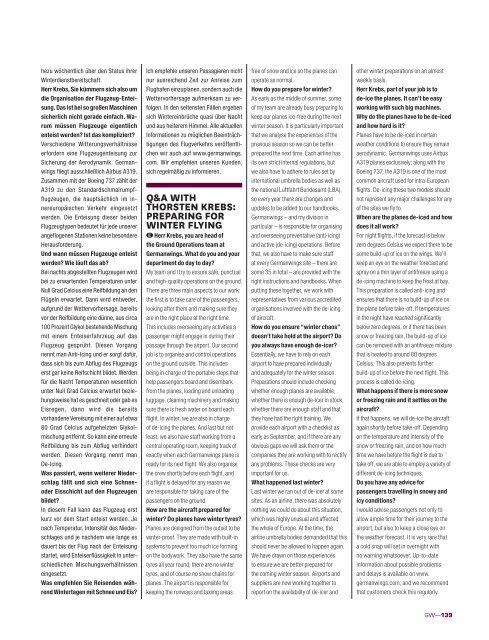december-2011
december-2011
december-2011
Sie wollen auch ein ePaper? Erhöhen Sie die Reichweite Ihrer Titel.
YUMPU macht aus Druck-PDFs automatisch weboptimierte ePaper, die Google liebt.
hezu wöchentlich über den Status ihrer<br />
Winterdienstbereitschaft.<br />
Herr Krebs, Sie kümmern sich also um<br />
die Organisation der Flugzeug-Enteisung.<br />
Das ist bei so großen Maschinen<br />
sicherlich nicht gerade einfach. Warum<br />
müssen Flugzeuge eigentlich<br />
enteist werden? Ist das kompliziert?<br />
Verschiedene Witterungsverhältnisse<br />
erfordern eine Flugzeugenteisung zur<br />
Sicherung der Aerodynamik. Germanwings<br />
fl iegt ausschließlich Airbus A319.<br />
Zusammen mit der Boeing 737 zählt der<br />
A319 zu den Standardschmalrumpfflugzeugen,<br />
die hauptsächlich im innereuropäischen<br />
Verkehr eingesetzt<br />
werden. Die Enteisung dieser beiden<br />
Flugzeugtypen bedeutet für jede unserer<br />
angefl ogenen Stationen keine besondere<br />
Herausforderung.<br />
Und wann müssen Flugzeuge enteist<br />
werden? Wie läuft das ab?<br />
Bei nachts abgestellten Flugzeugen wird<br />
bei zu erwartenden Temperaturen unter<br />
Null Grad Celcius eine Reifbildung an den<br />
Flügeln erwartet. Dann wird entweder,<br />
aufgrund der Wettervorhersage, bereits<br />
vor der Reifbildung eine dünne, aus circa<br />
100 Prozent Glykol bestehende Mischung<br />
mit einem Enteiserfahrzeug auf das<br />
Flugzeug gesprüht. Diesen Vorgang<br />
nennt man Anti-Icing und er sorgt dafür,<br />
dass sich bis zum Abfl ug des Flugzeugs<br />
erst gar keine Reifschicht bildet. Werden<br />
für die Nacht Temperaturen wesentlich<br />
unter Null Grad Celcius erwartet beziehungsweise<br />
hat es geschneit oder gab es<br />
Eisregen, dann wird die bereits<br />
vorhandene Vereisung mit einer auf etwa<br />
80 Grad Celcius aufgeheizten Glykolmischung<br />
entfernt. So kann eine erneute<br />
Reifbildung bis zum Abfl ug verhindert<br />
werden. Diesen Vorgang nennt man<br />
De-Icing.<br />
Was passiert, wenn weiterer Niederschlag<br />
fällt und sich eine Schnee-<br />
oder Eisschicht auf den Flugzeugen<br />
bildet?<br />
In diesem Fall kann das Flugzeug erst<br />
kurz vor dem Start enteist werden. Je<br />
nach Temperatur, Intensität des Niederschlages<br />
und je nachdem wie lange es<br />
dauert bis der Flug nach der Enteisung<br />
startet, wird Enteiserfl üssigkeit in unterschiedlichen<br />
Mischungsverhältnissen<br />
eingesetzt.<br />
Was empfehlen Sie Reisenden während<br />
Wintertagen mit Schnee und Eis?<br />
Ich empfehle unseren Passagieren nicht<br />
nur ausreichend Zeit zur Anreise zum<br />
Flughafen einzuplanen, sondern auch die<br />
Wettervorhersage aufmerksam zu verfolgen.<br />
In den seltensten Fällen ergeben<br />
sich Wintereinbrüche quasi über Nacht<br />
und aus heiterem Himmel. Alle aktuellen<br />
Informationen zu möglichen Beeinträchtigungen<br />
des Flugverkehrs veröffentlichen<br />
wir auch auf www.germanwings.<br />
com. Wir empfehlen unseren Kunden,<br />
sich regelmäßig zu informieren.<br />
Q&A WITH<br />
THORSTEN KREBS:<br />
PREPARING FOR<br />
WINTER FLYING<br />
Herr Krebs, you are head of<br />
the Ground Operations team at<br />
Germanwings. What do you and your<br />
department do day to day?<br />
My team and I try to ensure safe, punctual<br />
and high-quality operations on the ground.<br />
There are three main aspects to our work:<br />
the fi rst is to take care of the passengers,<br />
looking after them and making sure they<br />
are in the right place at the right time.<br />
This includes overseeing any activities a<br />
passenger might engage in during their<br />
passage through the airport. Our second<br />
job is to organise and control operations<br />
on the ground outside. This includes<br />
being in charge of the portable steps that<br />
help passengers board and disembark<br />
from the planes, loading and unloading<br />
luggage, cleaning machinery and making<br />
sure there is fresh water on board each<br />
fl ight. In winter, we are also in charge<br />
of de-icing the planes. And last but not<br />
least, we also have staff working from a<br />
central operating room, keeping track of<br />
exactly when each Germanwings plane is<br />
ready for its next fl ight. We also organise<br />
the crew shortly before each fl ight, and<br />
if a fl ight is delayed for any reason we<br />
are responsible for taking care of the<br />
passengers on the ground.<br />
How are the aircraft prepared for<br />
winter? Do planes have winter tyres?<br />
Planes are designed from the outset to be<br />
winter-proof. They are made with built-in<br />
systems to prevent too much ice forming<br />
on the bodywork. They also have the same<br />
tyres all year round; there are no winter<br />
tyres, and of course no snow chains for<br />
planes. The airport is responsible for<br />
keeping the runways and taxiing areas<br />
free of snow and ice so the planes can<br />
operate as normal.<br />
How do you prepare for winter?<br />
As early as the middle of summer, some<br />
of my team are already busy preparing to<br />
keep our planes ice-free during the next<br />
winter season. It is particularly important<br />
that we analyse the experiences of the<br />
previous season so we can be better<br />
prepared the next time. Each airline has<br />
its own strict internal regulations, but<br />
we also have to adhere to rules set by<br />
international umbrella bodies as well as<br />
the national Luftfahrt Bundesamt (LBA),<br />
so every year there are changes and<br />
updates to be added to our handbooks.<br />
Germanwings – and my division in<br />
particular – is responsible for organising<br />
and overseeing preventative (anti-icing)<br />
and active (de-icing) operations. Before<br />
that, we also have to make sure staff<br />
at every Germanwings site – there are<br />
some 35 in total – are provided with the<br />
right instructions and handbooks. When<br />
putting these together, we work with<br />
representatives from various accredited<br />
organisations involved with the de-icing<br />
of aircraft.<br />
How do you ensure “winter chaos”<br />
doesn’t take hold at the airport? Do<br />
you always have enough de-icer?<br />
Essentially, we have to rely on each<br />
airport to have prepared individually<br />
and adequately for the winter season.<br />
Preparations should include checking<br />
whether enough planes are available,<br />
whether there is enough de-icer in stock,<br />
whether there are enough staff and that<br />
they have had the right training. We<br />
provide each airport with a checklist as<br />
early as September, and if there are any<br />
obvious gaps we will ask them or the<br />
companies they are working with to rectify<br />
any problems. These checks are very<br />
important for us.<br />
What happened last winter?<br />
Last winter we ran out of de-icer at some<br />
sites. As an airline, there was absolutely<br />
nothing we could do about this situation,<br />
which was highly unusual and affected<br />
the whole of Europe. At the time, the<br />
airline umbrella bodies demanded that this<br />
should never be allowed to happen again.<br />
We have drawn on those experiences<br />
to ensure we are better prepared for<br />
the coming winter season. Airports and<br />
suppliers are now working together to<br />
report on the availability of de-icer and<br />
other winter preparations on an almost<br />
weekly basis.<br />
Herr Krebs, part of your job is to<br />
de-ice the planes. It can’t be easy<br />
working with such big machines.<br />
Why do the planes have to be de-iced<br />
and how hard is it?<br />
Planes have to be de-iced in certain<br />
weather conditions to ensure they remain<br />
aerodynamic. Germanwings uses Airbus<br />
A319 planes exclusively; along with the<br />
Boeing 737, the A319 is one of the most<br />
common aircraft used for intra-European<br />
fl ights. De-icing these two models should<br />
not represent any major challenges for any<br />
of the sites we fl y to.<br />
When are the planes de-iced and how<br />
does it all work?<br />
For night fl ights, if the forecast is below<br />
zero degrees Celsius we expect there to be<br />
some build-up of ice on the wings. We’ll<br />
keep an eye on the weather forecast and<br />
spray on a thin layer of antifreeze using a<br />
de-icing machine to keep the frost at bay.<br />
This preparation is called anti-icing and<br />
ensures that there is no build-up of ice on<br />
the plane before take-off. If temperatures<br />
in the night have reached signifi cantly<br />
below zero degrees, or if there has been<br />
snow or freezing rain, the build-up of ice<br />
can be removed with an antifreeze mixture<br />
that is heated to around 80 degrees<br />
Celsius. This also prevents further<br />
build-up of ice before the next fl ight. This<br />
process is called de-icing.<br />
What happens if there is more snow<br />
or freezing rain and it settles on the<br />
aircraft?<br />
If that happens, we will de-ice the aircraft<br />
again shortly before take-off. Depending<br />
on the temperature and intensity of the<br />
snow or freezing rain, and on how much<br />
time we have before the fl ight is due to<br />
take off, we are able to employ a variety of<br />
different de-icing techniques.<br />
Do you have any advice for<br />
passengers travelling in snowy and<br />
icy conditions?<br />
I would advise passengers not only to<br />
allow ample time for their journey to the<br />
airport, but also to keep a close eye on<br />
the weather forecast. It is very rare that<br />
a cold snap will set in overnight with<br />
no warning whatsoever. Up-to-date<br />
information about possible problems<br />
and delays is available on www.<br />
germanwings.com, and we recommend<br />
that customers check this regularly.<br />
GW—139














